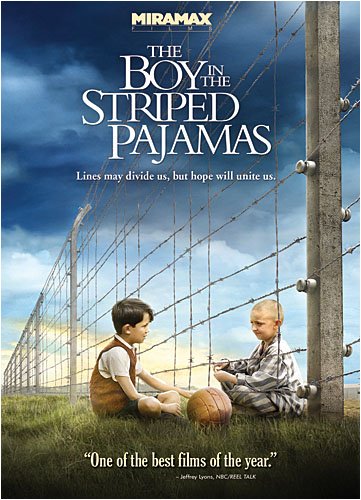
Though it’s been more than 60 years since the end of the Second World War, it still seems to be every filmmaker’s favorite subject. Every year, I see more WWII-based movies—and with each new one that’s released, I become a little more cynical.
Yes, WWII was a significant event in history—one that we should never let ourselves forget. But when it comes to WWII movies, it seems that filmmakers rarely have anything new to offer. In fact, I’ve seen so many similar WWII movies that I was starting to think I’d become desensitized—until writer/director Mark Herman proved me wrong.
Based on the novel by John Boyne, Herman’s The Boy in the Striped Pajamas shows WWII and the Holocaust from a truly unique perspective—through the eyes of a child. When his father (David Thewlis) is promoted to commandant in the Nazi army, eight-year-old Bruno (Asa Butterfield) is forced to leave his home in Berlin and move with his father, his mother (Vera Farmiga), and his older sister, Gretel (Amber Beattie), to a new house in the country.
From the window in his new bedroom, Bruno can see that they’re living next to what he thinks is a farm—but the “farmers” all appear to be wearing striped pajamas. Knowing that the “farm” next door is really a concentration camp, Bruno’s mother forbids him from leaving the yard. But Bruno doesn’t have anyone to play with, and he soon becomes bored—so he sneaks out and makes his way next door. There, he meets Shmuel (Jack Scanlon), a boy his age who lives in the camp.
Though the two boys are separated by a big electric fence, Bruno and Shmuel become friends—which only makes it harder for Bruno to understand why the Jews are supposed to be his enemy.
The Boy in the Striped Pajamas is a surprisingly powerful film that builds in potency as the minutes pass. That’s due, in part, to the film’s unique perspective—because it’s one that you’ve probably never thought about. But it’s also because it’s such a character-driven film. The characters are both well-developed and solidly portrayed—and they’re sure to pull you into their story.
Bruno is a sweet and adorable little boy who still looks at the world in wide-eyed wonder. He’s adventurous but obedient—and, like most little boys, he thinks his father can do no wrong. When he befriends Shmuel, however, everything begins to change. He begins to realize that his father might not be right—and, in fact, he might not be such a good man. Though Asa Butterfield is just a little boy, he portrays his character’s awe and wonder—as well as his hurt and confusion—almost flawlessly. It’s devastating to watch him change—to see him start doubting and even fearing his father.
Farmiga, too, tells the story from a similar perspective—that of a dutiful Nazi wife who’s left in the dark about what’s going on next door. She tries to be supportive—and obedient—but when she discovers the truth, her world begins to fall apart. And, like Butterfield, she gives an absolutely heartbreaking performance.
The Boy in the Striped Pajamas is one of the most powerful films I’ve seen all year. It’s beautiful and engaging, and it’s absolutely heartbreaking. Although it’s often difficult (and even devastating) to watch, it’s not to be missed.
DVD Review:
Sometimes, I just don’t understand why some films get all the attention while others go almost completely unnoticed. How, I wonder, does a cold and distant film like The Reader get nominated for an Oscar for best picture, while an accessible and heartbreakingly unforgettable film like The Boy in the Striped Pajamas gets nothing? How is it that Kate Winslet wins an Oscar for best actress, but Vera Farmiga, who gives a much more moving performance, doesn’t even get nominated? It just doesn’t make any sense.
For those of you who missed The Boy in the Striped Pajamas when (or if) it played in theaters near you, I highly recommend picking it up on DVD. The DVD also offers a few extras: a 20-minute making-of feature, a handful of deleted scenes, and an audio commentary track with writer/director Mark Herman and author John Boyne. The feature and the commentary both give additional insights into the story—as well as the making of the film—and they’ll certainly give you more to think about when you re-watch the film. But the highlight of this disc is still the film itself. It’s not an easy film to watch, and it’s sure to leave you feeling emotionally drained, but it’s a film that you’ll definitely never forget.


